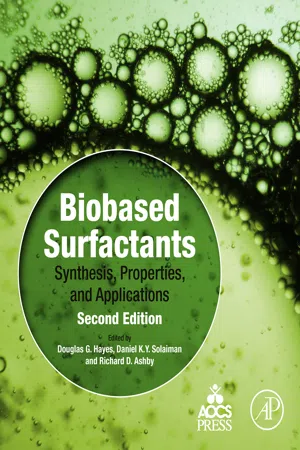7.1 Introduction
Phospholipids (PLs, also refer to glycerophospholipids) are a subclass of lipids that generally consist of a glycerol backbone with I,2-positions connected to two fatty acyl groups via ester bonds. The third glycerol position is connected to a phosphate group. The phosphate group bears two ester bonds to glycerol backbone and a polar head group, such as choline, ethanolamine, inositol, serine, and glycerol. The polar head groups correspond to the subspecies of PLs: phosphatidylcholine (PC), phosphatidylethanolamine (PE), phosphatidylinositol (PI), phosphatidylserine (PS), and phosphatidylglycerol (PG), respectively. Structurally, all PLs are amphiphilic molecules, serving as the molecular basis for their biological functions and as emulsifiers in food, cosmetic, or drug products.
The fundamental biological function of PLs is to form cellular membranes and act as a barrier for entry of compounds into cells. PLs also function as precursors of second messengers such as diacylglycerol (DG) and inositol-1,4,5-P3 (inositol trisphosphate). A third, and usually overlooked, function of PLs is the storage of energy in the form of fatty acyl components (Vance and Vance, 2008). Other specific functions are associated with specific organs and involve unique molecular species of PLs. Pulmonary surfactant PLs are essential for life. They are composed of a complex lipoprotein-like mixture that lines the inner surface of the lung to prevent alveolar collapse at the end of expiration (Agassandian and Mallampalli, 2013). PS is a component of the lipid‑calcium-phosphate complex for deposition during bone formation (Merolli and Santin, 2009), regulation of apoptosis (programmed cell death) (Devitt et al., 2003), and blood coagulation (Lentz, 2003). A better understanding of the biological functions in the human body not only helps us to know the role and mechanism of PLs to maintain structure and function but also facilitates the development of ingredients or drug excipients of phospholipid analogues for better health or to address dysfunction or diseases occurring in tissues or organs.
In 1956, using rat liver as an enzyme source, Kennedy and Weiss (1956) elucidated a pathway for the de novo biosynthesis of PE and PC. The PE and PC branches of this “Kennedy” pathway are based upon the formation of characteristic high-energy intermediates: cytidine diphosphate (CDP)-ethanolamine, for the synthesis of PE, and CDP-choline, for the synthesis of PC (Gibellini and Smith, 2010). After the Kennedy and Weiss study, a few researches shed some light on the importance and regulation of individual pathways, but progress in biochemical and molecular analysis was slow. Many enzymes in these pathways are membrane- associated and therefore difficult to purify, and kinetic analysis of reactions with insoluble substrates and products was not straightforward (Kent, 1995). However, with the advances in gene analysis, expression, and purification of protein and structural analysis of enzymes, the biosynthesis pathways of PLs are much more clear, and the branching pathways for biosynthesis of specific phospholipid species have been deciphered (Lykidis, 2007).
With respect to PLs, the food engineers and application scientists have different contents from biologists or pharmaceutical researchers, which generally refer to “lecithins.” The word “lecithin” comes from the Greek “λέκιθος,” meaning “egg, the start of life.” Nowadays, lecithins often refer to “a complex mixture of acetone-insoluble phosphatides, which consist chiefly of PC, PE, PS, and PI, combined with various amounts of other substances such as triglycerides, fatty acids, and carbohydrates as isolated from a crude vegetable oil source. It contains > 50% of acetone-insoluble matter” (van Hoogevest and Wendel, 2014). Soybean, sunflower, and rapeseed are the major sources of vegetable lecithins. In general, PLs are excellent surface-active amphiphilic molecules, which are widely used as emulsifier, wetting agent, solubilizer, and as the major compone...
